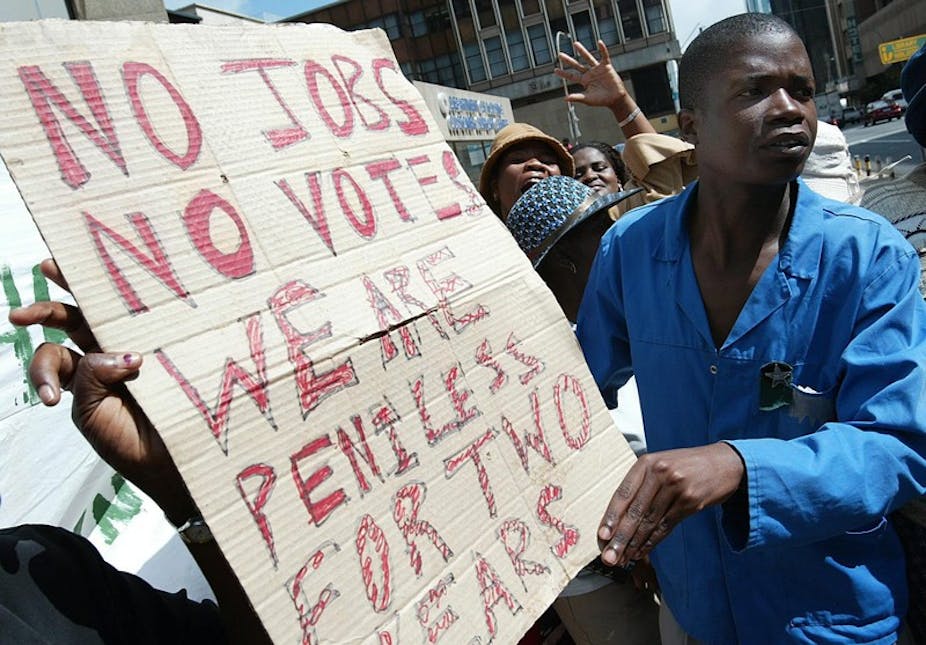After two decades of democracy, economic inequality in South Africa remains very high. Survey comparability issues make analysing trends tricky, but it is clear that overall income inequality has not fallen; the country has long been one of the highest ranked by Gini coefficient, a widely used measure of income inequality. Its peak of about 0.72 in the late 2000s is one of the highest ever recorded.
But some interesting sub-trends are clear to see. The Theil index, which allows us to take inequality between groups and inequality within groups separately, shows that inter-group gaps now make up only 35% of South Africa’s income disparity.
This figure is much higher than in many other societies, although it’s also far lower than the 1993 rate of 61%. While the income gap between races has narrowed, the sharp decline in the Theil index indicates that inequality rose a lot within race groups – and the reasons for this are clear.
Beyond black and white
Much of the difference between the black and white populations stems from the new forces shaping distribution in post-apartheid South Africa. After 1994, the black population experienced broad income gains across the board; better-educated black people gained the most, since they were best positioned to grasp the new opportunities for upward mobility, and visible black middle and high-income classes rapidly arose.
The black middle class in particular grew from 300,000 in 1993 to 3m in 2012, and blacks’ share of the middle class from 11% to 41%. The new black middle class began with few assets, and this meant their initial consumption patterns were noticeably distinct from those of the white middle class.
Even poorer black people benefited to some extent from the new order. This was not because of market opportunities; the poorest are still stuck at the back of a long job queue, one that was only slightly shortened by the millions of new jobs created in the prosperous 2000-2008 period. To the extent the poor have improved their lot, more credit should go to government policy.
Because economic conditions allowed looser fiscal constraints, the rapid growth of the new Child Support Grant, a means-tested social grant that now goes to 11m children under the age of 18, reduced poverty greatly. But because the income gains of the poor were lower than those of the black middle class, income gaps amongst blacks widened. The Gini coefficient of 0.66 amongst black people is even higher than Brazil’s.
Income inequality within the white population also grew, but for quite a different reason. Most white people now also have higher incomes than at the end of apartheid – though high school fees, medical costs and costs of maintaining security eroded these gains, and white incomes are actually growing relatively slowly.
Poorer and less well-educated whites were the only clear losers. They lost the job protection they had enjoyed under apartheid, while the value of their social pensions and other grants was reduced when grants were equalised. White inequality has therefore also grown.
After the transition, black voters expected better housing and municipal infrastructure, and improved healthcare and education. Provision of “hard” services improved, as delivery of housing, water, sanitation and electricity could be contracted out to private providers. But building quality suffered because of the haste with which this was done. Also, rapid house-building was much easier when there was more open land available; now complex community negotiations are needed to upgrade squatter areas. This has greatly slowed the delivery of new housing stock.
The limits of state capacity are clearest in the provision of “soft” services like healthcare and schooling. Shifts in public spending to provide more clinics and to equalise education spending did improve access and teacher-pupil ratios, but the quality of many of these services is abysmal. Many poor people with serious health conditions prefer to visit private practitioners at their own cost rather than use the low quality free public clinics. And education in most schools is so weak that South African primary school children on average perform worse on international tests than children from its much poorer neighbour, Swaziland.
Poor outlook
Income redistribution prospects are not good. The roots of income inequality are in the labour market; the Gini coefficient for South African wages is 0.60. With the exception of grants, which slightly improve distribution, other factors push the household Gini number even higher: household size and composition (the poor have more children), unemployment (which affects the poor more), and dividends and property income (which go to the rich).
The shortage of skills means that wages are much higher for the relatively small number who are highly skilled, while there is a surplus of low-skilled workers. This creates a floor for overall income inequality – and as a result the large wage gap between the skilled and unskilled will long remain.
State policy has not had much of an effect. Grants have reduced poverty, but cannot affect inequality much, and the fiscal space for expanding the social grant system is now limited. High inequality probably will remain a feature of South African society for decades to come, at least until education and services radically improve and their benefits are felt in the labour market.

